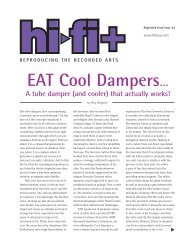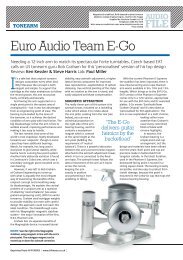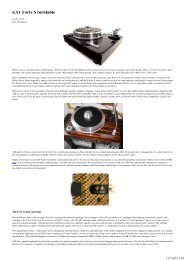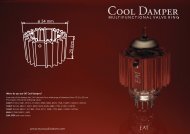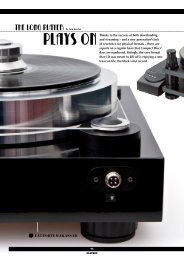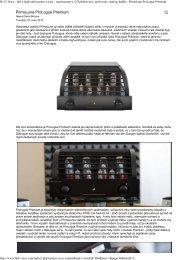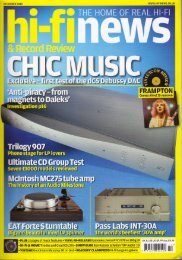Euro Audio Team KT88 Diamond valves - EuroAudioTeam.com
Euro Audio Team KT88 Diamond valves - EuroAudioTeam.com
Euro Audio Team KT88 Diamond valves - EuroAudioTeam.com
Create successful ePaper yourself
Turn your PDF publications into a flip-book with our unique Google optimized e-Paper software.
AUDIO SMORGASBORD<br />
<strong>Euro</strong> <strong>Audio</strong> <strong>Team</strong><br />
<strong>KT88</strong> <strong>Diamond</strong> <strong>valves</strong><br />
by Chris Binns<br />
When twenty years ago, the MO valve<br />
<strong>com</strong>pany closed its doors for the last<br />
time at the Hammersmith plant and<br />
production of <strong>valves</strong> ceased, they<br />
could hardly have foreseen the way in<br />
which the market was to regenerate<br />
steadily to the apparently quite<br />
healthy state that it is in today. By<br />
1984 the general world demand for<br />
<strong>valves</strong> was at an all time low, and<br />
most other <strong>com</strong>panies had already<br />
stopped production; the MO Co.<br />
were I think the last people making<br />
<strong>valves</strong> in this country. Their last shot at<br />
the audio industry involved marketing<br />
the KT66, 77 and 88 under the Gold<br />
Lion banner (with a suitable increase<br />
in selling price), but there were not<br />
enough <strong>com</strong>panies making<br />
thermionic equipment to make<br />
it viable, and demand from the<br />
military was dwindling fast as<br />
<strong>com</strong>munication equipment became<br />
solid state. Since that time, the KT<br />
series of <strong>valves</strong> (which unlike <strong>valves</strong><br />
such as the EL34 were at that time<br />
manufactured solely by MO) have<br />
reached iconic status while the <strong>KT88</strong><br />
in particular has be<strong>com</strong>e something<br />
of a legend, and ostensibly a<br />
benchmark for other manufacturers to<br />
aspire to. In more recent years<br />
numerous <strong>com</strong>panies have been<br />
making product that is advertised as<br />
‘an exact copy’ or ‘built to the original<br />
MO specification’, some allegedly<br />
using the original machinery from the<br />
English factory (which is possibly<br />
true) while one <strong>com</strong>pany advertises a<br />
British made <strong>KT88</strong>; to the best of my<br />
knowledge this is at the present time,<br />
fiction.<br />
So, was the original <strong>KT88</strong> all that<br />
it was cracked up to be? Maybe<br />
it is worth putting a few things in<br />
perspective regarding the venerable<br />
status of the MO <strong>KT88</strong>. It was<br />
introduced in 1957 as a more<br />
powerful relative of the popular<br />
KT66, and at a time when 25<br />
Watts was considered a lot, its<br />
capabilities must have<br />
seemed formidable with<br />
outputs of up to a hundred<br />
Watts from a single pair, the<br />
only <strong>com</strong>petition being the American<br />
made 6550 from <strong>com</strong>panies such as<br />
RCA, Sylvania and GE (not to be<br />
confused with the British <strong>com</strong>pany<br />
GEC who were parent <strong>com</strong>pany of<br />
MO). See the side bar for more details<br />
of the differences and similarities<br />
between these two important audio<br />
<strong>valves</strong>.<br />
While the general standard of<br />
manufacturing, and more importantly<br />
quality control of the <strong>KT88</strong> was pretty<br />
good, performance did vary. Take for<br />
example the CV labelled military<br />
version(s) of the valve; it is rightly<br />
assumed that examples of these<br />
have a tighter specification as they<br />
were often used in demanding<br />
applications such as driver <strong>valves</strong><br />
in transmitters and radar. What is<br />
less well known is that rather than<br />
creaming off the best samples from a<br />
production run, the military version<br />
was manufactured in a different<br />
part of the factory to a higher<br />
tolerance. Sometimes part of the<br />
machinery of the main production<br />
line would break down, and a<br />
portion of the military specified<br />
<strong>valves</strong> would be diverted and labelled<br />
as <strong>com</strong>mercial stock; these were<br />
significantly superior to the standard<br />
product. Either way, the <strong>KT88</strong><br />
maintained a reasonable standard<br />
throughout its production which left<br />
one hell of a void when it ended.<br />
With interest in thermionic<br />
technology at an all time low, the<br />
available alternatives were either the<br />
aforementioned 6550’s from GE, Philips<br />
or Sylvania, or Chinese bottles labelled<br />
<strong>KT88</strong> which often behaved more like<br />
fire crackers than <strong>valves</strong>; using them in<br />
powerful amplifiers was a hazardous<br />
and frequently damaging experience.<br />
Even assuming that the new <strong>valves</strong><br />
fired up okay, often they would prove<br />
unstable with time, and suffer a short<br />
life span, expiring in a fit of sparks and<br />
usually smoke as your treasured amp<br />
went up as well. (But I should mention<br />
<strong>com</strong>panies such as Gold Aero, who<br />
fastidiously tested NOS (new old stock)<br />
and other such <strong>valves</strong> to provide a<br />
viable alternative for the thermionically<br />
inclined audiophile.)<br />
Two things happened to improve<br />
the situation to its current healthy<br />
status; there was a resurgence of<br />
interest in <strong>valves</strong> for audio use in the<br />
late eighties, and the change in the<br />
political situation in and around Russia
meant access to stock that had hitherto<br />
remained hidden. While there was no<br />
direct Soviet replacement for the <strong>KT88</strong>,<br />
it was not long before the factories<br />
that had been producing <strong>valves</strong> for<br />
the military were persuaded that it<br />
would make good <strong>com</strong>mercial sense to<br />
produce one, and there is now a wide<br />
selection available. As a (sometime)<br />
user of large power amplifiers that were<br />
designed around a dozen original MO<br />
<strong>KT88</strong>’s, I have tried most of these<br />
different breeds. It is testament to the<br />
healthy situation that I have been<br />
meaning to carry out an extensive<br />
report for the magazine on current<br />
6550 / <strong>KT88</strong>’s for quite some time, but<br />
such is the extent of available <strong>valves</strong> it<br />
has be<strong>com</strong>e a daunting and<br />
unmanageable prospect.<br />
But it was fairly obvious from the<br />
first time I saw them that the EAT<br />
<strong>valves</strong> were rather<br />
special.<br />
Everything from<br />
the packaging<br />
through to the<br />
individual<br />
certificate of<br />
performance smacks<br />
of quality and care, and<br />
if at times it seems like<br />
overkill, consider that quite<br />
a high percentage of valve<br />
failure is due to mechanical<br />
damage through bad handling.<br />
The bottles themselves look<br />
equally as impressive, with an<br />
internal construction that would<br />
appear to be identical to the MO<br />
original; externally, the glass envelope<br />
is slightly more elongated in shape<br />
while the base is one piece plastic<br />
rather than metal shrouded.<br />
EAT stands for <strong>Euro</strong> <strong>Audio</strong> <strong>Team</strong>,<br />
and it is a cooperative effort from<br />
several countries, the mission being<br />
to produce the best possible <strong>valves</strong>.<br />
Parts are made in a division of the<br />
original Tesla factory in Prague, the<br />
assembly and detailed testing is carried<br />
out in Switzerland. The <strong>KT88</strong> is a fairly<br />
recent and wel<strong>com</strong>e introduction as<br />
EAT have to date been specialising in<br />
large triodes for SE use such<br />
as the 52B and 32B, the result of recent<br />
development by Alesa Vaic, as well as<br />
the traditional 300B. The <strong>com</strong>pany is<br />
confident enough in their product to<br />
provide a full one year guarantee for<br />
each valve, an unprecedented step as<br />
far as I know, and<br />
one which goes a<br />
long way to<br />
ameliorate<br />
spending out<br />
on specialist<br />
product.<br />
Assessment of<br />
the <strong>valves</strong> was<br />
carried out in two stages.<br />
Doing any kind of direct A/B<br />
<strong>com</strong>parisons was always going to be<br />
difficult owing<br />
to the time involved in running in,<br />
settling and biasing issues, and almost<br />
impossible when using the twelve<br />
<strong>valves</strong> required by the big amplifiers.<br />
To enable <strong>com</strong>parisons to be carried<br />
out I opted to first try a quartet of the<br />
EAT’s in a Rogue <strong>Audio</strong> Model 90,<br />
kindly loaned by Kevin Walker of<br />
<strong>Audio</strong>craft. This amplifier runs a pair<br />
AUDIO SMORGASBORD<br />
of 6550 / <strong>KT88</strong>s in ultra linear to<br />
provide a nominal 90 Watts, and the<br />
straightforward biasing arrangement<br />
enabled a fairly swift substitution to<br />
gauge relative performance. Also<br />
present at these listening sessions<br />
were RG and Nigel Finn of the Chord<br />
Company. The Rogue <strong>com</strong>es supplied<br />
with good quality Electroharmonix<br />
6550s, a Sovtek sourced valve which<br />
has been recently gaining a good<br />
reputation and is used by<br />
quite a few<br />
manufacturers in<br />
their products. This<br />
particular set were<br />
probably at their<br />
optimum, having been<br />
used for 40 to 50 hours.<br />
Substituting the EAT <strong>KT88</strong>’s<br />
was something of a revelation;<br />
even without the luxury of<br />
warming up the difference was<br />
quite startling. I think Roy summed<br />
it up by saying that it sounded as<br />
if we were listening to an<br />
amplifier at three times the<br />
price, which was no<br />
exaggeration. Indeed, had<br />
someone told us that the<br />
EATed Rogue was the next<br />
model up the range it would<br />
have presented a perfectly<br />
reasonable proposition!<br />
The EAT’s had an authority that<br />
seemed to enhance every aspect of the<br />
performance; the bass was firmer,<br />
deeper and much more articulate, the<br />
mid was more open and spacious,<br />
while the treble had detail and clarity<br />
that had not been there before. The<br />
overall increase in focus and<br />
transparency was remarkable. Nigel<br />
suggested that it made the original<br />
tubes sound ‘shagged’ (which they<br />
weren’t), and the disappointment was<br />
intense when we returned to them.<br />
To put things in perspective, I had a<br />
set of Svetlana <strong>KT88</strong>’s that I have been<br />
recently using, and to date have been<br />
my choice of the readily available<br />
<strong>valves</strong>. Differences between them
AUDIO SMORGASBORD<br />
and the Electroharmonix were<br />
interesting but minor, while there was a<br />
similar leap in performance with the<br />
EAT’s in situ. The acid test involved a<br />
set of original MO <strong>KT88</strong>’s that I have<br />
clung on to for many years, really to<br />
use as a <strong>com</strong>parison in such<br />
circumstances as this, and as such, I<br />
would say that they are about half way<br />
through there life. While they sounded<br />
pretty good, superior to the Svetlana’s<br />
and Electroharmonix, they could not<br />
manage the sheer exuberance and<br />
taughtness of the EAT’s. It did occur to<br />
me however, that while there<br />
had been a general<br />
consensus<br />
that the<br />
EAT’s<br />
were just<br />
‘better’ in<br />
every<br />
respect, the<br />
character of<br />
the MO’s was a<br />
shade more laid back<br />
and therefore less<br />
obviously impressive.<br />
Another <strong>com</strong>parison suggested<br />
that this was true, but they could<br />
not match the EAT’s for colour, texture<br />
and in particular, definition.<br />
The next evaluation took place<br />
over a longer period using twelve of<br />
the EAT <strong>valves</strong> in the big amplifiers<br />
described earlier. The demands here<br />
are a little different from the Rogue<br />
amp as the <strong>valves</strong> are potentially<br />
pushed a bit harder with 550 Volts<br />
on the anodes, while matching seems<br />
to be an important criteria when<br />
it <strong>com</strong>es to absolute sound quality,<br />
and not just under static conditions.<br />
Using the EAT <strong>KT88</strong>’s in these proved<br />
to be every bit as dramatic as the<br />
previous session, perhaps even more<br />
so. While I have never been<br />
disappointed with the bottom end of<br />
these 250 Watt amplifiers, it has never<br />
been a match for something like the<br />
Bryston. The use of the EAT’s was<br />
startling in this respect, and the grip<br />
and bite exerted on the loudspeaker<br />
was much improved, to the extent that<br />
the amplifier would go considerably<br />
louder into difficult and inefficient<br />
loudspeakers; once again the result<br />
was a better amplifier. Musically, it felt<br />
as if several layers had been removed,<br />
and the slight sense of vagueness that<br />
has always been there diminished to<br />
imperceptible levels, with a real<br />
improvement in definition, a factor<br />
facilitated by what looked to be<br />
extremely close matching of the <strong>valves</strong>.<br />
Going back to the Svetlana’s or Sovtek’s<br />
was very disappointing.<br />
There is no doubt that the EAT<br />
<strong>valves</strong> are extremely<br />
good. The big<br />
question is<br />
that at ninety<br />
pounds per<br />
piece (and an<br />
extra three<br />
pounds apiece for<br />
matching) – roughly<br />
three times the price of<br />
say, a Svetlana – are they<br />
worth it? Judging by what I have<br />
heard, the answer is very definitely,<br />
yes. On performance alone, I think the<br />
results speak for themselves, while the<br />
security of a full years warranty makes<br />
it a considerably safer investment. What<br />
I cannot tell you at this stage is how<br />
long they will last, and how well they<br />
will stay matched over that time period.<br />
But so far, the indications are good,<br />
and I will certainly be following this<br />
aspect up.<br />
So, you are looking for the best?<br />
Original MO <strong>KT88</strong>’s are still available –<br />
just – at highly elevated prices, and I<br />
reckon you might be able to get a<br />
supposedly unused pair on ebay for<br />
around £250.00. There will be no<br />
guarantee; they will almost certainly<br />
not be matched, and it’s unlikely they<br />
will sound as good as the EAT’s.<br />
Truly a worthy successor to the<br />
esteemed British king.<br />
<strong>KT88</strong> versus 6550<br />
While developed independently on both sides<br />
of the Atlantic, the <strong>KT88</strong> and 6550 are broadly<br />
speaking, electrically (and pin out) <strong>com</strong>patible,<br />
although there are differences in the internal<br />
construction. The <strong>KT88</strong> has slightly higher<br />
ratings in terms of absolute voltage (800 as<br />
opposed to 600 Volts on the anode) but the<br />
dissipation and electrical characteristics are<br />
similar. Although the 6550 is classed as a<br />
pentode, and the <strong>KT88</strong> a tetrode (i.e. one less<br />
electrode) there is an explanation for this.<br />
During the time of development, Mullard were<br />
applying for a patent on the ‘pentode’, where<br />
the inclusion of a fifth electrode (sometimes<br />
called the suppressor grid) connected to the<br />
cathode was used to collect stray electrons<br />
and reflect them back to the source. The KT –<br />
standing for kinkless tetrode – incorporated a<br />
form of beam shaping that actually amounted<br />
to another electrode to achieve a similar<br />
result, but avoided infringement of the<br />
patent. As for the sonic differences, these days<br />
I suspect that there is more difference<br />
between different manufacturer’s product<br />
than between the <strong>KT88</strong> and 6550 per se. To<br />
confuse the issue further, some suppliers will<br />
produce an identical batch of <strong>valves</strong> and label<br />
them according to the market demand; I have<br />
had an example of each from the same<br />
manufacturer, and breaking them open<br />
revealed that they were absolutely identical.<br />
Price:<br />
£90 ea. with matched pairs<br />
as standard<br />
Quartets and beyond - £3 extra/valve<br />
Contacts:<br />
UK Distributor<br />
Art <strong>Audio</strong> (UK) Ltd.<br />
Tel. (44)(0)11 5963 7795<br />
Manufacturer<br />
<strong>Euro</strong> <strong>Audio</strong> <strong>Team</strong><br />
Net. www.euroaudioteam.<strong>com</strong>




